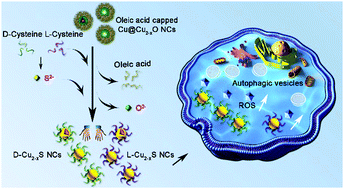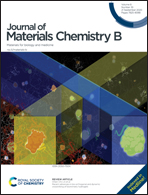Near-infrared optically active Cu2−xS nanocrystals: sacrificial template-ligand exchange integration fabrication and chirality dependent autophagy effects†
Abstract
We herein report a (sacrificial template-ligand exchange) integration strategy to fabricate near-infrared optically active Cu2−xS nanocrystals (NCs) and further investigate their interactions with cells, autophagy-induced tumor cell death, and photothermal ablation application potential. Starting from oleic acid capped Cu@Cu2−xO NCs, water-soluble and chiral D- and L-cysteine modified Cu2−xS (denoted as D-Cu2−xS and L-Cu2−xS, respectively) NCs have been reliably obtained by ligand exchange (from oleic acid to cysteine) accompanied by the core chemical transformation (from Cu@Cu2−xO to Cu2−xS). The resulting two enantiomeric Cu2−xS NCs have almost identical physicochemical properties including size, morphology, chemical composition, extinction band, peroxidase mimicking activity, and photothermal stability. The only exception is that the D- and L-Cu2−xS NCs exhibit mirror symmetric circular dichroism signals ranging from the ultraviolet to near-infrared region. The cellular uptake of the D-Cu2−xS NCs is about three times higher than that of their enantiomeric counterparts, which is likely attributed to their higher affinity with the cytomembranes of tumor cells (HepG2 and HeLa cells). As a result, a more prominent cellular autophagy proceeds due to the more significant production of highly reactive oxygen species. Then, the ablation of cells can be further enhanced by photothermal effects of the Cu2−xS NCs. Meanwhile, for normal cells, due to very limited cellular uptake effects, little cytotoxicity has been observed for both D- and L-Cu2−xS NCs.



 Please wait while we load your content...
Please wait while we load your content...